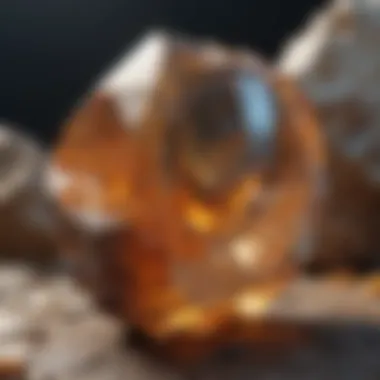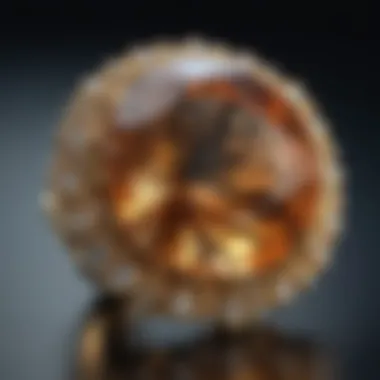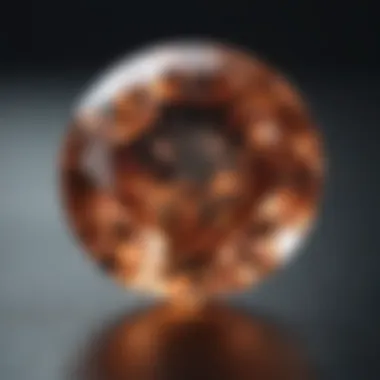Understanding Topaz: The Multifaceted Gemstone Insights


Intro
Topaz, a captivating gemstone, has long been admired for its beauty and variety. Much like the multitude of colors it exhibits, the features of topaz are diverse, making it a subject of extensive interest among both collectors and casual admirers. The allure of this mineral extends beyond its aesthetics into its geological formation, cultural significance, and practical applications.
Overview of Gemstones and Minerals
Understanding topaz begins with a broader appreciation of gemstones and minerals as a whole. They have been an integral part of human culture for millennia, serving as symbols of wealth, status, and spiritual significance. The rich history of gemstone use can be traced back to ancient civilizations, where specific stones were revered for both their beauty and believed powers.
History of Gemstone and Mineral Use
Historically, gemstones have been used for adornment, spirituality, and cultural practices. Ancient Egyptians adorned themselves with lapis lazuli, symbolizing royalty. In the East, jade represents purity and moral integrity. Each gemstone carries a narrative interwoven with cultural heritage, forming a crucial aspect of identity across societies. Topaz, specifically, has been valued since antiquity, regarded as a stone of strength and healing.
Significance in Culture and Society
In various cultures, gemstones hold unique meanings. Topaz is associated with love and affection, often gifted to symbolize strong bonds. Celebrated in myths, the gem is believed to bring wisdom and tranquility.
Gemstone Formation and Properties
The formation of topaz is a fascinating geological process. Like other gemstones, it originates deep within the Earth's crust, where intense heat and pressure create the conditions necessary for its development.
Formation Process of Gemstones
Topaz typically forms in granitic rocks through a process known as crystallization. The mineral is often created from the cooling of magma or through hydrothermal processes that involve hot, mineral-rich fluids. Understanding this process is essential for appreciating the uniqueness of each specimen.
Properties that Define Gemstones
Gemstones are distinguished by their physical properties, such as hardness, luster, and color. Hardness is measured on the Mohs scale, with topaz scoring an impressive eight, making it durable and suitable for various uses.
Classification based on Color, Hardness, and Luster
Topaz is renowned for its range of colors, which can include blue, yellow, pink, and clear variants. Each color variant, influenced by trace elements present during formation, plays a role in the gemstone's value. The lustrous finish of well-cut topaz contributes as well to its overall appeal.
Identifying and Evaluating Gemstones
Identifying genuine topaz involves understanding its unique characteristics, including its refractive index and crystal structure.
Factors Affecting Gemstone Value
The value of topaz can fluctuate based on several factors: rarity of the color, clarity, cut, and overall aesthetics. For example, blue topaz is highly sought after, while yellow and brown varieties tend to be less valued.
Techniques for Gemstone Identification
Gemologists use various techniques to verify authenticity, from simple visual inspections to advanced methods like spectroscopy. Knowledge of these techniques can enhance one’s ability to appreciate and collect gemstones responsibly.
Assessing Gemstone Quality
Quality assessment requires careful consideration of the Four Cs: Color, Clarity, Cut, and Carat weight. Each aspect plays a pivotal role in determining both aesthetic and monetary value.
Caring for Gemstones
Proper care is essential for preserving the beauty of topaz and other gemstones. Understanding the proper cleaning methods can prolong their lifespan.
Cleaning and Storing Gemstones Properly
Topaz should be cleaned with mild soap and water, using a soft cloth or brush. Storing it in a fabric-lined box or individual pouches can prevent scratches and deterioration.
Avoiding Common Mistakes in Gemstone Care
Avoid exposing topaz to harsh chemicals or extreme temperatures, which can damage its surface or color. Awareness of these pitfalls ensures a longer lifespan for the gemstone.
Preservation Tips for Specific Gem Types
Each type of topaz may have specific care instructions. For instance, treated topaz, such as some blue varieties, may require additional caution to maintain its coloring.


Understanding and caring for topaz properly can enhance its beauty and longevity, making it a cherished part of any collection.
By exploring the multi-dimensional aspects of topaz, one gains a deeper appreciation of this gemstone’s allure and significance.
Prelims to Topaz
Topaz as a gemstone holds notable significance in the collection and use of natural stones. Its admission leads us into a deeper understanding of its physical, chemical, and historical aspects. As we explore this brilliant gem, it becomes clear that topaz is not merely a beautiful stone but a complex mineral that has captured human intrigue for centuries.
Overview of Topaz
Topaz is a silicate mineral composed mainly of aluminum, silicon, and fluorine. It is renowned for its diverse colors and clarity. Natural topaz can be found in hues ranging from yellow, blue, and pink to colorless. This variability is one of its greatest attractions. The gemstone's hardness, rated at eight on the Mohs scale, asserts its durability, making it suitable for various uses in jewelry ranging from rings to pendants. In addition to being an admired decorative item, topaz is believed to have metaphysical properties, often associated with love and healing.
Historical Background
Historically, topaz holds a rich narrative. The ancient Egyptians revered it, attributing its golden hues to the sun god Ra. Similarly, the Romans valued the stone for its supposed connection to divine favor. In the Middle Ages, topaz was believed to guard against envy and promote strength. Its historical importance underscores its enduring presence in culture and mythology. Today, topaz is appreciated not just for its aesthetic appeal but also for its storied past that shapes its identity. Understanding topaz's background adds context to its value and significance in contemporary use and collection.
Geological Formation of Topaz
Understanding the geological formation of topaz is crucial for grasping its value and nature as a gemstone. This section elucidates both the mineral's composition and its formation process, offering insight into why these factors are critical for enthusiasts and collectors.
Mineral Composition
Topaz is a silicate mineral composed primarily of aluminum and fluorine. Its chemical formula is Al(2)SiO(4)(F,OH)(2). The presence of different trace elements can lead to variations in color and clarity. Key elements in topaz include:
- Aluminum: Fundamental for its crystal structure.
- Silicon: Contributes to the silicate framework.
- Fluorine: Plays a role in the mineral’s formation and hardness.
- Hydroxyl: Can substitute for fluorine in some cases, affecting the properties of the stone.
The combination of these minerals creates a durable gemstone that is often used in jewelry. Understanding its composition allows gemologists to identify topaz accurately and assess its quality and value in the market.
Formation Process
The formation of topaz occurs primarily in igneous rocks, particularly in granite and rhyolite. It can also be found in metamorphic rocks. The process involves several stages:
- Cooling of Magma: Topaz forms from the crystallization of magma as it cools slowly under the earth’s surface.
- Fluorine-rich environments: The presence of fluorine is essential for topaz to form. This element often comes from related minerals that release fluorine as they break down.
- Hydrothermal Deposits: Topaz can also originate from hydrothermal processes, where hot, mineral-rich water alters existing rocks, allowing topaz to crystallize within them.
- Erosion and Transport: After formation, erosion may expose topaz, allowing it to be deposited in sedimentary environments. This exposure can lead to the formation of secondary deposits, making it more accessible for mining.
Understanding the formation process of topaz enhances appreciation for its natural origins and the conditions required for its development.
In summary, the geological formation of topaz is pivotal not just for recognition purposes but also for understanding its inherent value in jewelry and industrial applications. By studying its mineral composition and formation processes, enthusiasts can better appreciate the gem's unique characteristics.
Physical Properties of Topaz
The physical properties of topaz play a crucial role in understanding this stunning gemstone. These characteristics offer insights into its formation, durability, and aesthetic appeal. Knowing the hardness and optical features of topaz is essential for enthusiasts and professionals alike, as they influence everything from gem evaluation to care and maintenance in jewelry applications.
Hardness and Durability
Topaz is well known for its remarkable hardness. It ranks 8 on the Mohs scale of mineral hardness. This places it just below diamond, making it resistant to scratches and wear. This aspect is significant for both jewelers and consumers. Jewelry that contains topaz can withstand the rigors of everyday wear more successfully than softer gemstones.
Moreover, the durability of topaz makes it a preferred choice in pieces that are worn frequently, such as rings and bracelets. However, it is not entirely indestructible. Topaz can still be chipped or fractured if subjected to substantial impact. Thus, while it is robust, care should still be taken during wear and cleaning.
- Applications:
- Everyday wear: Topaz is suitable for jewelry designed for frequent use.
- Collectible pieces: Its hardness allows it to be part of intricate designs without fear of damage.
In summary, the impressive hardness and durability of topaz profoundly influence its value and desirability in the marketplace.
Optical Characteristics
The optical characteristics of topaz are another fascinating aspect to consider. This gemstone is renowned for its clarity and brilliance. It often exhibits a transparent appearance, allowing light to pass through and create vibrant reflections. This feature makes topaz highly sought after in fine jewelry.
The color range of topaz is diverse, encompassing shades like yellow, blue, and pink. Some colors occur naturally, while others are the result of treatment processes. The way topaz interacts with light contributes to its value. For example, blue topaz is particularly alluring and has gained widespread popularity in the market.
- Key Optical Traits:
- Refraction: High refractive index increases sparkle and shine.
- Color Play: Variety in colors due to natural formation and treatments.
- Market Preferences:


- Natural colors are often more valued than treated shades.
- Collectors appreciate the unique optical features of specific types.
Color Variations in Topaz
Color variations in topaz are significant for several reasons. They contribute to the gemstone's appeal, value, and individuality. The diverse colors of topaz can influence buyer preferences and market trends. Understanding these variations helps collectors and jewelers make informed decisions. Moreover, it emphasizes the role of topaz in cultural symbolism.
Natural Color Spectrum
Topaz occurs in a variety of natural colors, which can include colorless, blue, green, yellow, and pink, among others. Each of these colors has unique characteristics that affect its desirability and uses. Colorless topaz, for instance, is often used as a substitute for diamonds. Blue topaz, prized for its clear and vivid hues, is a popular choice for jewelry. The natural blue color occurs in various shades, primarily produced through irradiation and heat processes.
Yellow and golden topaz can present a rich, warm appearance and are often seen as more valuable, particularly when displaying deeper hues. Pink or red topaz is rarer and carries a premium. Green topaz may appear more frequently but has less demand. This natural color spectrum is crucial for understanding market dynamics and customer preferences.
Treated Colors and Market Trends
In addition to the natural colors, treated topaz has become increasingly popular. Treatments like heat and irradiation enhance or change topaz colors, creating shades that are not found naturally. For example, the processes can produce stunning, vibrant blues or deeper yellows. Market trends reveal a growing acceptance of treated stones, as they can offer a more affordable option for consumers without sacrificing beauty.
Understanding these treatments is crucial for buyers. They need to differentiate between natural and treated stones, as this impacts value. Misrepresentation can lead to dissatisfaction and distrust in the industry. Recent trends show that treated topaz, especially in vibrant blue hues, has seen a rise in popularity among consumers.
Cultural Significance of Topaz
Topaz holds a unique place in various cultures and traditions throughout history. Its vibrant colors and clarity have led to numerous interpretations and uses over time. This section discusses the symbolism and folklore surrounding topaz as well as its uses in jewelry and fashion. Understanding its cultural significance allows us to appreciate topaz beyond its physical attributes.
Symbolism and Folklore
Topaz is often associated with several symbols and meanings. In ancient times, it was believed to have protective qualities. Many cultures thought that wearing or carrying topaz could ward off harm, bringing luck and relief from negative energy. The gemstone was also a symbol of wealth and power.
In Hindu mythology, topaz is recognized as a gemstone that brings strength and success. Similarly, in ancient Egypt, it was linked to the sun god, Ra, signifying its brightness and warmth. Additionally, folklore often describes it as a stone that promotes love and affection. It is said to bring harmonious relationships, increase communication, and even enhance creativity.
Notable Folklore:
- Egyptian Beliefs: Used for protection in the afterlife.
- Hindu Traditions: Associated with strength and success.
- Greek Mythology: Linked to clarity of thought and enlightenment.
Identification of Genuine Topaz
Identifying genuine topaz is a crucial part of appreciating and valuing this gemstone. Not only does this process aid in distinguishing a real topaz from synthetic or imitation stones, but it also gives insight into the gemstone's quality, origin, and potential worth. For gemstone enthusiasts, collectors, and jewelry designers, this knowledge is paramount, ensuring authenticity in purchases and reinforcing trust in the gem market.
Visual Characteristics
When it comes to the visual characteristics of topaz, specific features help in its identification. Genuine topaz typically exhibits a glass-like luster and can range from transparent to translucent. One distinct feature to look out for is the way light interacts with the stone. Authentic topaz displays a brilliance due to its ability to refract light, often resulting in vibrant flashes of color when properly cut.
Moreover, the color inclusivity can be another telling characteristic. Natural topaz usually contains some inclusions, like tiny mineral traces or color zoning. These blemishes can help differentiate it from flawless synthetics. Additionally, the surface of genuine topaz often lacks the overly polished shine seen in cheaper imitations.
In terms of shape, topaz commonly comes in either octagonal or cushion cuts. This is primarily due to how the gemstone is processed. The cut can reveal much about its authenticity.
Testing Methods
To ensure the genuineness of topaz, several testing methods can be employed. Each method provides different layers of assurance about the stone's authenticity. Here are a few practical approaches:
- Magnification Test: Using a loupe, inspect the gemstone closely. Genuine topaz typically shows inclusions. A lack of inclusions may indicate a synthetic stone.
- Refractive Index Measurement: Topaz has a specific refractive index, ranging between 1.609 and 1.630. A refractometer can help measure this; discrepancies may signal a fake.
- Hardness Test: Topaz has a hardness of 8 on the Mohs scale. Using a tool, you can scratch materials of lower hardness to see if the topaz remains unscathed. However, this should be done cautiously to avoid damaging the stone.
- Specific Gravity Test: Authentic topaz has a specific gravity of approximately 3.49 to 3.57. Measuring the weight of the stone and comparing it to its size can help in identifying its authenticity.
"Knowing how to identify genuine topaz not only protects your investment but also enhances your appreciation for this remarkable gemstone."
By combining visual inspection with scientific testing methods, it becomes feasible to ascertain the authenticity of topaz confidently. This knowledge serves as a foundation for gemstone enthusiasts, ensuring they acquire true pieces rather than imitations.
Caring for Topaz
Caring for topaz is essential for preserving its beauty and longevity. Effective maintenance and proper storage techniques are crucial. This ensures that the gemstone retains its brilliance and does not suffer from potential damage over time. When considering the value of topaz, both monetary and sentimental, investing time and attention in care practices pays off significantly.
Maintenance and Cleaning
Cleaning topaz requires diligence yet is straightforward. Start by using a soft, lint-free cloth to gently wipe the surface. For more thorough cleaning, a mild soap solution is effective. Avoid using harsh chemicals or abrasive materials that can scratch or dull the stone. Rinse the topaz under warm water to remove soap residue and dry it gently.
Important Tips for Maintenance:
- Regularly inspect for scratches or damage.
- Clean after wearing to prevent buildup of oils and dirt.


For stunning stones like blue topaz, remember that their brilliance comes from clarity and cleanliness. Regular maintenance not only enhances appearance but helps in identifying any potential issues early.
Storage Recommendations
Proper storage of topaz is vital to prevent scratching and chipping. It is best to store topaz separately from other gemstones using soft pouches or lined jewelry boxes. This minimizes the risk of scratches from harder stones. Additionally, avoid exposing topaz to extreme temperatures and direct sunlight, as this can cause color changes over time.
Storage Guidelines:
- Keep in a soft pouch or compartmentalized box.
- Away from direct sunlight and extreme heat.
- Consider using silica gel packets to control humidity.
These recommendations help maintain the integrity of topaz and ensure it is always ready to shine beautifully, whether for special occasions or daily wear.
"By taking care of your topaz, you invest in its future, ensuring that its beauty withstands the test of time."
Ethical Sourcing of Topaz
The importance of ethical sourcng of topaz cannot be overstated. In an age where consumers are aware of the origins of their purchases, sourcing plays a vital role in both the environment and the communities involved in mining. Understanding the ethical implications of topaz sourcing is crucial, as it not only impacts the ecological balance but also addresses social concerns surrounding labor practices.
Environmental Considerations
Mining for topaz can lead to significant ecological disturbances. The extraction process often results in habitat destruction, soil erosion, and water contamination. To mitigate these dangers, sustainable mining practices are recommended. These might include:
- Minimizing land disruption: Employing techniques that reduce surface damage can help preserve local ecosystems.
- Rehabilitation of mining sites: After extraction, companies should engage in efforts to restore the natural environment.
- Water management: Proper treatment and disposal of wastewater are essential to preventing pollution in nearby water bodies.
It is imperative for gem enthusiasts and consumers to support businesses that adhere to sustainable methods. This fosters a more responsible marketplace and protects the planet for future generations.
Fair Trade Practices
Fair trade practices in the topaz market are designed to promote ethical labor conditions. These practices ensure that miners and workers receive fair compensation and work in safe environments. Some key aspects of fair trade in topaz sourcing include:
- Fair wages: Workers should be compensated fairly and equitably for their labor.
- Safe working conditions: Mining operations must adhere to safety protocols to protect laborers.
- Community support: Benefits from mining should extend back to local communities, funding education, health services, and infrastructure improvement.
By prioritizing fair trade practices, consumers can contribute to a more just and equitable marketplace. Supporting these initiatives can generate positive change for both workers and the environment. It enables an informed choice that reflects the values and ethics of conscientious purchasing.
Topaz in Alternate Uses
Topaz is widely known for its stunning beauty and usage in jewelry. However, its applications extend beyond adornment. Understanding the alternate uses of topaz offers a deeper appreciation of this remarkable mineral. It showcases not only the material's versatility but also highlights its significance in various fields.
Industrial Applications
Topaz finds various roles in industry. Its hardness and durability make it suitable for certain practical uses. For example, the gemstone often serves in cutting and grinding tools. Specifically, industrial quality topaz, often called 'topazite', can be utilized as an abrasive material. This capability stems from its position on the Mohs scale, where it sits at an impressive 8. This strength allows topaz to cut or grind softer materials efficiently. Its resistance to corrosion adds to its appeal in industrial settings.
Another aspect of topaz's industrial application is in the electronics industry. Due to its unique properties, it can be used in temperature and pressure sensors. These sensors are crucial in ensuring that various machinery operates efficiently and safely. Thus, topaz's role in this sector may surprise many who primarily associate it with fashion and jewelry.
Role in Alternative Medicine
Topaz also holds a place in the realm of alternative medicine. Some practitioners suggest that this gemstone possesses healing properties. Those who believe in crystal healing claim that topaz can aid in emotional balance, foster tranquility, and stimulate mental clarity. Different colors of topaz are thought to affect the body in varied ways.
For instance, blue topaz is believed to promote calmness and reduce stress, while yellow topaz is often associated with activating the intellect. This perspective on topaz’s benefits connects to broader practices within holistic healing. However, empirical support for these claims remains limited.
"Topaz, whether used in industry or alternative medicine, demonstrates its multifaceted applications beyond mere aesthetics."
Ending
The conclusion section serves as a vital element in comprehending the various facets of topaz discussed throughout this article. Summarizing essential points reinforces the significance and unique characteristics of topaz as a gemstone. Understanding these elements enables enthusiasts and collectors to appreciate the gemstone not only for its aesthetic appeal but also for its geological origins and cultural relevance.
Furthermore, this section highlights critical considerations regarding the ethical sourcing and caring for topaz. As awareness grows around sustainability, recognizing how topaz is sourced influences buying choices. By addressing these aspects, readers are equipped with vital information that aids in making informed decisions when selecting topaz products.
In essence, the conclusion ties all previous content together, ensuring the reader retains a comprehensive grasp of this multifaceted gemstone.
Summary of Key Points
- Geological Formation: Topaz is formed under specific conditions involving aluminum and fluorine, leading to considerable variations in its properties.
- Physical Properties: The hardness and optical qualities of topaz make it a favored choice for jewelry.
- Color Variations: From natural colors to treated options, understanding the spectrum enhances the appreciation of topaz.
- Cultural Significance: This gemstone has deep-rooted symbolism in various cultures, influencing its uses in jewelry and spiritual practices.
- Identification: Methods for confirming the authenticity of topaz are essential for collectors.
- Care Recommendations: Proper maintenance extends the life and luster of topaz jewelry.
- Ethical Sourcing: Incorporating ethical practices in the mining of topaz is increasingly important in today's market.
Future Outlook on Topaz
The future of topaz appears promising, influenced by evolving consumer trends and increasing awareness around ethical sourcing. With more individuals prioritizing sustainable products, there may be a surge in demand for responsibly sourced topaz. This could encourage mining operations to adopt fair trade practices, benefiting communities involved in the extraction process.
Furthermore, advancements in gemology and technology for gemstone treatments may lead to new color variations and enhancements. As the gemstone market evolves, topaz will likely maintain its appeal, drawing interest from newcomers and seasoned collectors alike.
In summary, topaz stands as a gemstone of significant value, rich in history, culture, and future potential.







